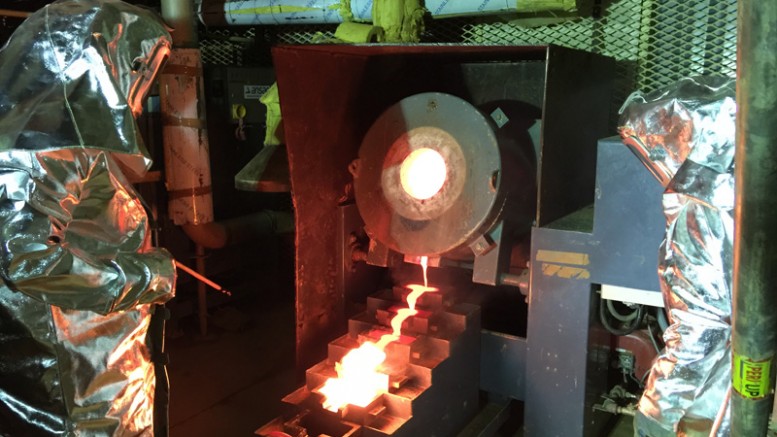Shares of Guyana Goldfields (TSX: GUY; US-OTC: GUYFF) plunged 46% to $1.62, on news that the company has cut its 2018 production guidance and launched a review of the underlying resource model at its Aurora gold mine in Guyana.
The company has hired engineering firm RPA Inc. to investigate the geologic controls and grade variability of the mine’s Rory’s Knoll deposit. Results of the review will be released next quarter, and incorporated into Guyana Goldfield’s 2019 guidance and its annual reserve and resource update.
The company also may revise the life-of-mine production profile.
The 2018 guidance revision was announced on Oct. 30, along with the company’s third-quarter results, and news that Patrick Sheridan had resigned as a director.
Sheridan had served as executive chairman from June 2013 to July 2018, when the company eliminated the executive chair position and streamlined the company’s organizational structure under president and CEO Scott Caldwell.
Because grades have not rebounded as quickly as the company had expected in the fourth quarter, Guyana Goldfields forecasts production this year of 150,000 to 155,000 oz. gold, down from the previous estimate of 175,000 to 185,000 oz. gold.
Management has also revised its cost estimates. Cash costs before royalties are now expected to come in at US$660 to US$685 per oz., and all-in sustaining costs (AISCs) are forecast to run to US$1,025 to US$1,050 per oz. gold. Cost of sales has been revised to US$1,030 to US$1,055 per oz. gold.
Despite improved mining rates, production and costs in the three months ended Sept. 30, the average head grade of 2.12 grams gold per tonne was lower than anticipated.
Since commercial production began in January 2016, mineralized material from the Rory’s Knoll diorite had reconciled well with reserves, the company stated in a news release.
“Previous guidance assumed that the average head grade would rebound to +3 grams gold per tonne throughout the current quarter,” the company said. “However, based on results to date, that no longer appears likely.”

The Aurora gold operation sits 170 km west of Georgetown, Guyana. Credit: Guyana Goldfields.
“This is disappointing news,” Caldwell told analysts and investors on a conference call. “We’re counting on Rory’s Knoll performing as it has historically, and unfortunately, it’s not performing in this particular area of the pit.
“We’ll work our way through this. I’m looking forward to the review by RPA. They are world-class professionals and I’m looking forward to their analysis, but I think the reconciliation is not as dire as it is, in this particular instance, on a global basis.”
The open-pit mine in northwestern Guyana, 170 km west of the capital of Georgetown, poured its first gold in August 2015.
A feasibility study by SRK Consulting in early 2017 described four mineralization areas at the Aurora gold mine project: Rory’s Knoll (which includes Walcott Hill East), Aleck Hill (which includes Alex Hill North), Walcott Hill and Mad Kiss (includes Mad Kiss West).
At the time, SRK estimated that 60% of the ore at the project would be sourced from Rory’s Knoll.
Ron Stewart, who joined Guyana Goldfields in September as its senior vice-president of technical services and corporate development, said on the conference call that because Rory’s Knoll is a stockwork of mineralization hosted by a diorite plug, “the fact that there’s some grade variation vertically isn’t a big surprise to any of us.”
He says that “it’s not a huge difference in terms of grade, but it’s enough to create this situation.”
On a positive note, Caldwell said, mining rates have shown a 17% improvement from the third quarter, while the mill is performing well, with throughput and recovery rates delivering above designed rates. He also noted that work has begun for an underground exploration drift.
“Unfortunately, we’ve got some review work to do on the resource model, and when that work will be completed in the next few months, we will be reviewing the entire resource model at Rory’s Knoll. So not just the open pit but the underground, as well,” he said on the conference call. “This is an isolated issue … as we mine through this area, we’ll get back on track.”
It’s not the first time this year that the company has revised its production and cost guidance for Aurora. In July, the company lowered its production guidance from 190,000 to 210,000 oz. gold to 175,000 to 185,000 oz. gold. It also raised cash cost estimates (excluding royalties) to US$535 to US$585 per oz. from US$430 to US$480 per oz., and AISCs from US$830 to US$880 per oz. to US$945 to US$995 per oz. gold.
The company said that the revisions were needed “due to the late arrival of the expanded haulage fleet and the later-than-planned mobilization of the contractor in the second quarter, which has deferred access to higher-grade ore to the fourth quarter of the year.”
At press time, Guyana Goldfields’ shares were trading at $1.79, up 10.5% on the day.
Over the last year, the company’s shares have traded in a range of $1.29 to $5.42.
Guyana Goldfields has 174 million shares for a $311-million market capitalization.


Be the first to comment on "Guyana Goldfields cuts production guidance at Aurora"